Nasturtiums care: expert tips on how to grow these hard-working plants
Find out how to grow nasturtiums for the ultimate edible flower, hardworking herb and useful companion plant that can boost your garden's vitality
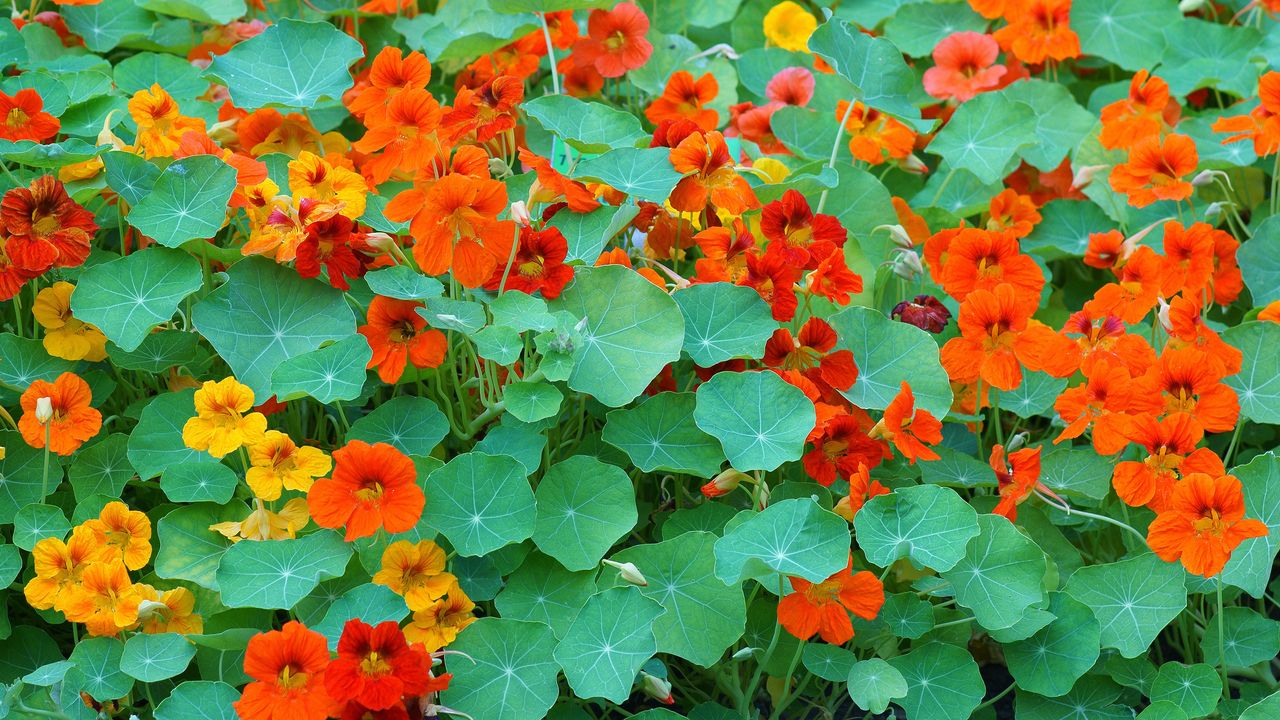

Whether you see nasturtiums as pretty flowers, creative herbs or easygoing ground cover, these bouncy, hardworking stalwarts tick plenty of boxes for gardens of all sizes and persuasions. Tumbling from pots and busy borders, clambering up trellises or anchoring bolder flower beds, their bountiful displays spill forth with pretty color. They are charmingly ornamental and delectably edible.
There’s something innately life-affirming, nurturing and generous about nasturtiums. They are an essential companion plant, protecting and nurturing the health of so many others. Like nature's finest helping hands, they serve as a hostelry for beneficial pollinators, while keeping pests from key veggies growing nearby.
These vigorous semi-hardy annuals (Tropaeolum majus and T. minus) are good for us, too, providing a peppery source of vitamin C and iron, carotene, B vitamins and iodine. Oh, and they give a boost to the central nervous system, removing carcinogens and strengthening blood vessels. What's not to love?
Growing nasturtiums brings a wealth of benefits to both your flower bed ideas and your wider plot. Here, we show you how to grow this useful plant with ease and efficiency – as dynamic ornamentals, helpful companions and truly uplifting edibles.
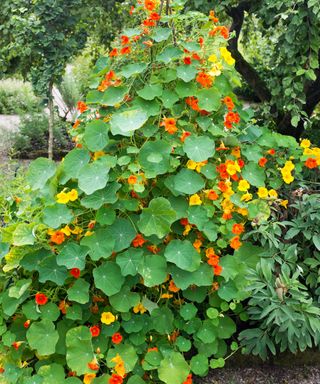
Climbing varieties of nasturtiums can quickly create impressive mounds of floral color in garden beds and borders
Where to plant nasturtiums
Nasturtiums are strong and adaptable plants. They are scrappy and resilient and respond well to tough conditions so will thrive in a variety of situations. They are equally happy in urban window box displays, courtyard gardens, small rock gardens and hanging baskets as in vast beds and borders. They even establish under trees, creating living carpets that quickly keep weeds at bay.
Nasturtiums favor poor, dry, sandy soils with good drainage (slightly acidic or neutral, with a pH of 6.5). Richer soils result in more foliage at the expense of flowering.
Whether you grow nasturtiums that are climbers, trailers or more compact, bushier types, they settle enthusiastically in all manner of settings. If your kitchen garden ideas involve raised beds, multiple levels or vertical gardening, these plants will be right at home.
Provide the right support, and many breeds quickly rise and spread up to 10ft (3m) high. Whether you're growing them on sunny patios or alongside more creative trellis ideas for gardens such as A-frames, X-frames, wigwams and obelisks, nasturtiums are not fussy about their growing space.
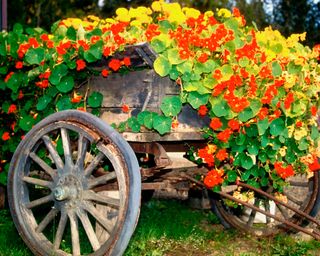
Nasturtiums are so easy growing, they quickly establish in the most unexpected places, like this wagon wheel cart-turned-container
When to plant nasturtiums
Nasturtiums are some of the quickest plants you can grow. They start producing flowers around six weeks after planting, between 35-50 days after germination, and can be harvested from 65 days. Germination takes 10-14 days, depending on variety.
Thanks to their long flowering periods, this presents you with a few options: use a greenhouse and sow early and successively under cover; sow direct when the ground is warmer; or mix and match, incorporating raised garden beds and containers in your plans.
Starting nasturtiums in a heated greenhouse or a polytunnel gives control over the early stages of the growing process as very young nasturtium plants benefit from the extra protection and steady temperatures. This is particularly true if you are starting off at the end of winter. These plants can then be hardened off and planted out when it is warmer outside (from late spring onwards in many areas).
So while sowing outdoors is fine from late spring, if you prefer to plant in a greenhouse then sowing indoors from early spring is also advised (six weeks before last frost). You can continue potting on, or plant outside in late spring. Late sowings (early to mid summer) will flower until first frosts.
Just remember nasturtium seedlings don’t like to be handled much; if you are starting in pots under glass, try coir pots (or similar) that can be planted whole.
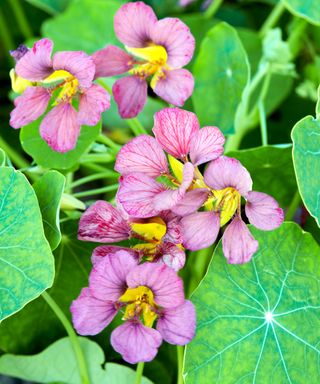
Nasturtiums such as ‘Purple Emperor’ from Suttons can be sown from early spring to mid summer for pretty old-fashioned cottage garden florals well into autumn
How to grow nasturtiums from seed
Nasturtiums are easy to grow from seed and there is little to prep before sowing. Many gardeners like to soak the seeds for eight hours (or nick a part of the seed) to assist with germination.
For the planting site, soil preparation mainly involves removing all weeds; remember, nasturtiums do best in poor soils and good sunlight. Germination is most successful when temperatures are 22°C, kept at around 24°C for healthy seedlings.
- Sow nasturtiums and start them off indoors: Plenty of varieties of nasturtiums can be started indoors from early spring for early flowering. Begin about a month before the last frost is due. If you know how to grow flowers from seeds, the basic principles for nasturtiums are much the same. Sow two or three seeds per 3in (8cm) pot at a depth of half an inch (1cm). Use a damp free-draining seed compost, water well and keep just moist. Seedlings emerge around 10 days after planting. Nasturtiums can get injured if you try moving them too soon, which is why it is best to use pots rather than trays.
- Pot on and plant out nasturtiums: For your early sown nasturtiums, think about moving them outside after the risk of frost has passed and the ground is warmer. Get plants used to the outdoors by hardening them off, moving them outside for increased periods for a week. If your plants have four true leaves, you can then plant them outside into raised garden beds, vegetable beds, flower beds or garden borders. Coir pots allow you to plant without disturbing the roots. Position so the crown of each plant is at soil level. Allow 8-12in (20-25cm) between plants. Water in well. Alternatively, once they are around 6in (15cm) tall, you can pot on your nasturtiums into large, deep containers. Mix two-thirds multi-purpose with one third grit or sand to ensure good drainage, and water well.
- Direct sow nasturtiums and grow outdoors: If you are starting nasturtiums in late spring, you can sow outside (either into warmer soil or into large containers). It is fine to sow direct once the last risk of frost has passed; just make sure the site is weed-free and sunny. Sow seeds half an inch (1cm) deep and 10-12in (25-30cm) apart on each side. Place two or three seeds in each planting hole and add a little compost mixed with sand. Germination should take no longer than two weeks. Keep the ground just moist. Add DIY cold frames, cloches or a fleece tent to give plants added protection as they adjust to life outdoors.
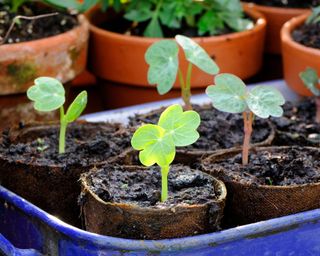
You can start nasturtiums off early undercover in good-sized pots in order to make the most of their flowering season
Do nasturtiums need a lot of sun?
Nasturtiums are low maintenance plants but one thing that really makes the difference to their overall health is sunshine. Originating in Columbia, Ecuador and Peru, nasturtiums do their best flowering in full sun. They can grow in partial sun (three-six hours a day) or filtered light, but you might find flowers are not as big or as plentiful.
It’s a good idea when growing nasturtiums to make sure they get sunshine for at least eight hours a day to grow at their best. While growing under glass, warmth and sunlight will see the fastest growth. Just keep a watchful eye on ventilation to avoid legginess and spindly seedlings. Once they are growing outside, nasturtiums are happy in zones 3-9, where temperatures are warm and kept at 50-75°F. They are also perfect in exposed sites, so work well as plants for rockeries, the open beds of cottage gardens or as part of sunny pergola ideas or patio schemes.
Heat and light, coupled with a warm, dry, well-draining soil or compost, are key to success with root development, foliage health and subsequent flowering.
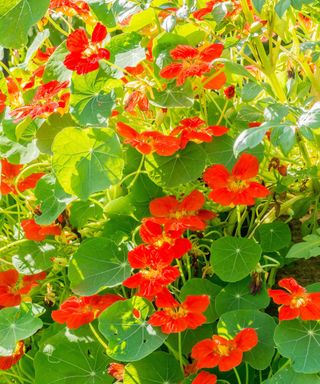
Nasturtiums such as the Alaska Series may be able to flourish even in poor conditions, but they prefer a site with plenty of sunshine
Growing nasturtiums in pots and hanging baskets
Nasturtiums will also thrive as part of your container gardening ideas, or in hanging baskets. The only things to bear in mind are sunshine and ample watering in dry spells – that, and selecting the right variety for your pots.
Nasturtiums make some of the best plants for hanging baskets and quickly establish; they also look lovely tumbling from large terracotta pots, half-barrels and window boxes. The trick is to make sure the container you choose has adequate drainage. Remember these plants prefer conditions on the dry side of moist, so avoid waterlogging. Leave around an inch of space between the compost level and the rim of the pot. You might find it also helps to add a little sand to your compost.
Plastic tubs and planters are easy to move outside to make the most of the summer months, while clay containers warm up quickly and give roots a boost. Don’t be afraid to combine your nasturtiums with other plants if you are also keen on growing vegetables in pots – and have fun experimenting with different containers.
You can buy nasturtiums as climbing, sprawling varieties or compact, bushy types. For container growing, bushy or dwarf varieties are good so as not to overwhelm the resources available. Some pretty smaller options include ‘Alaska Mixed’, ‘Empress of India’ and ‘Orchid Flame’. That said, a few trailing types like ‘Orange Gleam’ and ‘Purple Emperor’ can also look fantastic spilling over the sides of window boxes. So shop around and check your packet’s sowing instructions to see what is possible.
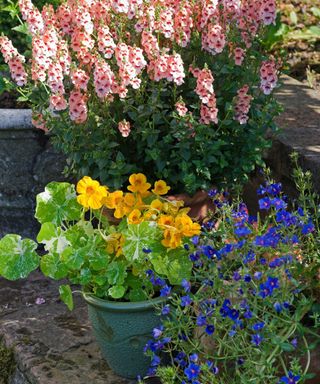
Potted nasturtiums do well in groups, as with these ‘Alaska Mixed’ grouped with Diascia ‘Aurora Apricot’ and Anagallis ‘Skylover’
How do I train nasturtiums to climb?
Depending on the variety, you will find a key factor in nasturtiums care is that they will benefit from a bit of support as they grow. Climbing varieties are intended to scramble up and over trellises, pergolas, inventive garden screening ideas, fences and walls, and quickly make short work of vertical opportunities. They won’t need much ‘training’ as such, as this is a natural impulse. Still, there are certainly things you can do to assist in the direction of travel.
First, be sure you pick a climbing variety if you are looking for a dedicated vertical spreader. Second, ensure your nasturtiums have plenty of space (and ample height) to spread and fill. And third, make sure the support is up to the task of holding plants steady as they grow – and check in regularly. If you aren’t sure which climbing plant support ideas are best, consider your options before planting.
The best frame is one that can showcase those pretty blooms, support the weight, let the plant develop freely and allow easy access for cutting and harvesting. Arch supports are good for balance; wigwams are pretty and low maintenance; and X-frames of hazel or bamboo (fastened at the intersection) are resilient and dynamic. Hazel is an excellent choice for pliability, while bamboo is strong, lightweight and weathers well.
Make sure any fastenings are kept secure and are attached to the support at regular intervals, but don’t suffocate stem growth. Nasturtiums will use tendrils to help them as they rise and spread, but diagonal braces, cables and ties are a good reinforcement. Good climbing nasturtium varieties to try include glowing orange ‘Jewel of Africa’, gold and tangerine ‘Whirlybird’, dusky ‘Black Velvet’, ‘Canary Creeper’, scarlet ‘Indian Chief’ and creamy ‘Yeti’ (with vines capable of reaching 80in).
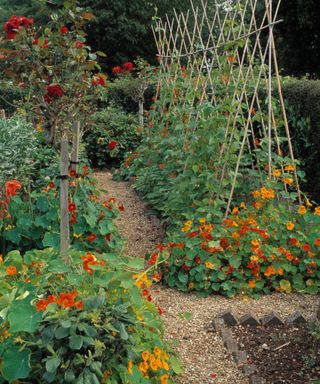
Nasturtiums being trained to climb up wigwam supports alongside runner beans in a potager garden with red roses
How to care for nasturtiums
When growing nasturtiums, you will quickly appreciate their carefree nature and how easygoing they are to cultivate. You won’t have to worry about exacting ground requirements or feeding regimes. Indeed, unfussy nasturtiums do better without nitrogen feeds, which can result in excess foliage and less impactful flowering. Gardeners often remark on how nasturtiums tend to thrive with the ‘tough love’ approach – they seem to respond best to a little bit of hardship and struggle.
Nasturtiums are drought-tolerant once established. So while you should spend a bit of time watering plants on a weekly basis, they are not likely to be pushed back by a bit of neglect. That said, an inch of water a week is likely to encourage more blossoms (more, if your nasturtiums are container-grown). It’s best to prevent the soil from drying out. A very light balanced potash feed every few weeks can boost flowers in the growing season, but go sparingly. And a light mulching with aged compost or organic matter will help to maintain levels in the ground – but again, moderation is advised.
Pinching back the tips can help stimulate growth in bushier varieties – but be sure not to do this with climbing breeds, as you may stop your plants in their tracks! You may also find that deadheading flowers will encourage more blooms over a longer period. However, let a few go to seed later in the season for planting the following year. If growing as container plants, a little pruning helps maintain shape in the growing season. Apart from this, nasturtiums will flourish with minimal care.
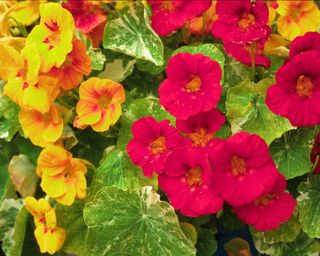
Compact varieties like petite mounding ‘Baby Rose’ and dwarf bushy ‘Alaska Mixed’ are surprisingly easy to care for
What are the main benefits of growing nasturtiums?
If you are looking for planting pals to bring out the best in your garden crops and fancies, few plants work harder than nasturtiums. Whether they are attracting pollinators, luring pests from precious veggies or boosting the flavors of neighbouring crops, nasturtiums are some of the best friends your gardening flora and fauna will ever find. So when it comes to companion planting, no garden is complete without them! Consider the following when deciding where to grow yours.
- One of the most beneficial plant partners for legumes, nasturtiums help to deter aphids from attacking your beans (their flowers also attract hoverflies, which eat aphids). They are often used as ‘decoy’ plants or ‘trap crops’ to lure such pests away. So if you are looking for plants that repel insects, nasturtiums should be top of your list.
- Nasturtiums make excellent companion plants for tomatoes and also some of the best companion plants for peppers as they help deter whitefly. This is one of the key pests for the Solanaceae (nightshade) family, so it can help if you want to know how to grow eggplant as well.
- Planting nasturtiums with fruiting plants can help confuse pests by disguising the smells produced by leaves and emerging fruits. Their pungent, peppery oils help to mask sweeter aromas. They are particularly good companion plants for strawberries, cucumbers and melons.
- As well as helping fight pests, the presence of nasturtiums can help to enhance the taste of neighbouring crops such as radishes and sweet potatoes. As a flavorsome herb in its own right, it also secretes oils into the ground that enhance the tang, vitality and heat of other roots.
- If you are looking for bee-friendly plants, you’re in luck: with their vibrant midsummer blooms, these plants are a magnet for bees – great news if you are looking for a boost for nearby crops. If you want to know how to grow winter brassicas, nasturtiums also lure small and large white butterflies away from cabbage, broccoli, kale and sprouting.
Nasturtiums are so giving, they even leave parting gifts. As they fall back to ground, they deposit calcium, nitrogen and potassium into the soil. This can help support future crops; for instance, next year’s peas and beans will benefit from the nitrogen left in the ground.
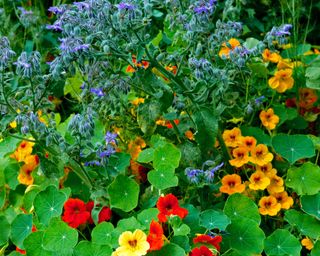
An example of proactive and colorful companion planting as orange nasturtiums are partnered with pretty blue herb borage
Potential problems growing nasturtiums
While nasturtiums care is generally low maintenance, there are a few key pests to watch out for. As we have shown, some pests arrive if you are deliberately growing nasturtiums to lure them from your small vegetable garden ideas, so think on. You have to decide what steps (if any) to take to curb pest numbers – depending on the pecking order of priorities in your garden. Watch the following key issues and act fast.
- Aphids: These pests (greenfly and blackfly) excrete a sticky dew, encouraging mould. Knowing how to get rid of aphids is a balancing act for nasturtium growers. Growing nasturtiums nearby does keep aphids off other key crops in your garden. Still, you can squash aphids by hand, use an organic spray or hose down plants. You could also try a biological control (nasturtium flowers do attract hoverflies, which feed on aphids).
- Cabbage whites: Large and small white butterflies lay their eggs on the undersides of nasturtium leaves. These hatch into caterpillars that eat the foliage. Again, great for keeping pests from precious brassicas. However, to prevent them destroying nasturtium plants, check plants regularly and squash eggs or caterpillars.
- Powdery mildew: While nasturtiums are pretty disease-tolerant, they can fall foul of powdery mildew. This presents as a spotty powdery fungus on leaves, stems or flowers. It tends to happen if plants are waterlogged. Make sure yours have free-draining soil and are well spaced. Also remove any old or visibly decayed leaves.
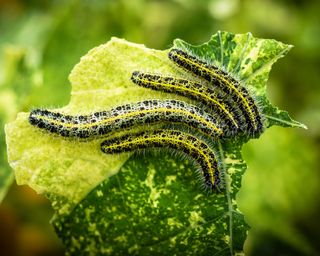
Cabbage white caterpillars such as those eating these ‘Alaska’ leaves are common nasturtium pests
Can I grow nasturtiums indoors?
While most gardeners find there is more space outside for nasturtiums to spread (and climb, depending on varieties), it is fine to keep them indoors. If you are craving new indoor plant ideas and are keen to know more about the best conservatory plants, a nasturtium is a beautiful and easy way to add long-flowering color and disc-shaped foliage. Some people like to add them to greenhouse beds to boost the vitality of crops like tomatoes. Just consider the space available. You may find it is preferable to keep your indoor nasturtiums in containers.
Nasturtiums give you a low-maintenance way of filling indoor spaces with color for months. Select a variety suited to having less space to play in, so opt for a compact or a dwarf breed. This means saying no to trailing types. Our tips on growing in pots (above) outline some good varieties – try bushy ‘Tom Thumb’, exotic-tinted ‘Ladybird Rose’, vibrant ‘Alaska Mixed’ and spicy ‘Empress of India’.
Nasturtiums are some of the best edibles for keeping under glass. Keep at 50-75°F and ensure plants receive at least six (preferably eight) hours of light a day; an east or south facing window is advised. Water regularly and keep compost moist. As with any of the best herbs to grow indoors you may find indoor growing creates softer flavors. While we generally advise against feeding nasturtiums, we make an exception for indoor growing. Add a slow-release multi-blend fertilizer to the potting soil (just avoid high concentrations of nitrogen, which stunt flower productivity).
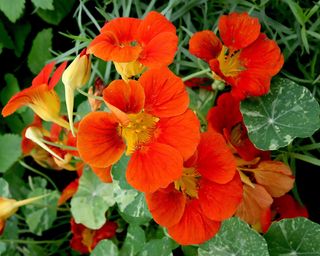
‘Empress of India’ is one of several compact nasturtiums that can be grown in a greenhouse or conservatory
When and how to harvest nasturtiums
Growing nasturtiums gives you another (rather peppery) advantage in addition to those discussed so far. When garnishing salads, sarnies and leaf dishes, these plants are a true feast for the senses.
The basic rules for harvesting nasturtiums are pretty straightforward. You can pick leaves as soon as the plant is 6in (15cm) tall. As for the flowers, these are best harvested as soon as they open, or thereabouts. So consider how many you can afford to take in one session to preserve the aesthetics of those that are left on the plant. A good rule is to take no more than 30% of the leaves to encourage more growth. Cut both with the stems attached using a pruner, secateurs or scissors.
One more thing: you are advised to leave your harvest for a few minutes after cutting. That way, any ‘residents’ have a chance to make good their escape – and you won’t wind up biting off more than you can chew!
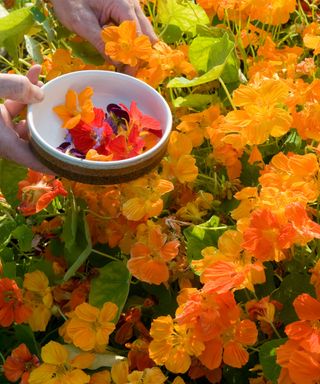
Harvest nasturtiums by handpicking flower heads or by using scissors or a knife after the plant reaches 6in tall
Which parts of nasturtiums are edible?
As long as what you harvest is fresh and free from disease then delicious vitamin- and mineral-packed nasturtiums are one of the top edible flowers as every part is up for grabs. For those who appreciate the peppery freshness of watercress, the young leaves of Tropaeolum majus are a tangy mustard twist in salads and sandwiches (nasturtiums are also known as Indian cress).
Unlike certain edible blooms, however, these flowers aren’t as sweet as they might look. Yes, they are nectar producing and are amongst the best plants for pollinators, but nasturtium flowers are spicier on the tongue. Those hot notes are dazzling in fresh dishes, helping accent the freshness of other ingredients – and are piquant juxtaposed with fruit such as raspberry or citrus. For those of you who want to grow your own herbal tea, the dried flowers of nasturtiums (a natural antibiotic) also make a satisfying brew.
And that’s not all. Even the seed pods can be nibbled on. The seed pods are commonly known as ‘poor man’s capers’ and can be used as a tasty alternative. Pick when mature and pickle them in vinegar.
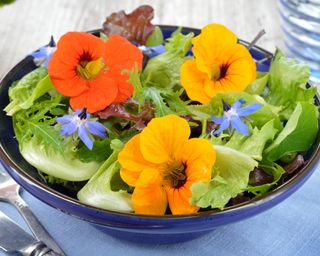
Brighten up a summer salad and turn a plate into a work of art with edible nasturtium petals and borage blooms
Do nasturtiums come back every year?
Often, gardeners aren’t sure if these vigorous long-flowering beauties are annuals or perennials. Certainly, a few are bred to last, like the climbing flame nasturtium (Tropaeolum speciosum) and trailing ‘Hermine Grashoff’. Yet a few other nasturtium varieties can be started later in the year and overwintered under glass as tender perennials. But most varieties for home-growing are sold as annuals. And as a general rule, these don’t tend to survive their first contact with winter frosts.
That said, your humble nasturtium does tend to flower like it’s going out of business – and keeps going until those first severe frosts, when it will quietly turn up its toes.
If you have fallen in love with a particular variety or two, why not try collecting seeds from flowers in early fall, and using them the following spring? Stored in a cool, dry place, these seeds are an excellent way of harnessing the magic of your cherished plants from year to year.
In mild areas, nasturtiums can self-sow, so you’ll be greeted with seedlings before you know it. Furthermore, if you know how to take cuttings from plants, you might want to try taking some 6in (15cm) stem tip cuttings to extend your flowering options. And don’t forget, even after your plants have faded and decomposed, they can keep giving to your garden in the form of a nutritious mulch!
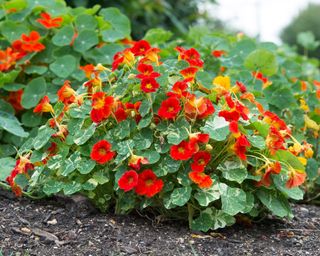
Nasturtiums like ‘Orange Troika’ make spectacular annual displays and with care will flower well into mid fall
How many varieties of nasturtiums are there?
Nasturtiums are a genus of flowering plants covering 80 species. As a genus, this group of plants originated in Central and South America. Those likely to act as the best ground-cover plants or as vibrant edging to sunny patio gardening ideas are usually hybrids of Tropaeolum majus, T. minus and T. peltophorum. And as we have seen, varieties range from bushy dwarf types to sprawling high climbers. Bushy plants reach 15in tall, while climbing (vining) breeds can be 6ft (1.8m) long.
Selecting the best varieties for your garden depends on your growing needs. It’s a choice between wanting to grow plants indoors or outside; growing them as ground cover or keeping them in a container; wanting something capable of spilling across walls or trellises – or something more compact and manageable.
For those intending to fuse herbal, edible and ornamental needs in a potager garden, the choices may be more complex than for those looking to occupy young gardeners in a child-friendly garden – luckily, there is plenty of choice to go around.
For most gardeners, garden color schemes will take precedence. Growing nasturtiums gives you a chance to experiment with a broad palette from softest, creamiest yellows to deepest velvety blacks, and everything in between. Have fun experimenting with some of the following – and if you can’t decide on one, try a few!
- Oranges: Bask in the feel-good ‘Firebird’, the near-neon vibrancy of ‘Orange Troika’ and dark tangerine ‘Empress of India’ with blue leaves.
- Duo-tones: Go for red-spotted creamy ‘Ladybird’; splotchy purple and gold ‘Bloody Mary’; ‘Peach Melba’ for soft orange and raspberry hues; and sizzling ‘Orchid Flame’ with its soft lemon and blush pink petals.
- Pinks: From the quaint and vintage loveliness of ‘Purple Emperor’ to the spicy floral pops of bright cerise in ‘Baby Deep Rose’.
- Burgundies: Sumptuous ‘Crimson Emperor’, poppy-style majesty of ‘Mahogany Gleam’ and sultry chocolate decadence of ‘Black Velvet’.
- Mixed: Try vivid ‘Alaska Series’ with flowers in yellow, cream, salmon and red, offset with marbled foliage; compact ‘Tom Thumb’; ‘Whirlybird’ for large blooms; or ‘Phoenix’ for serrated petals in red, orange and gold.
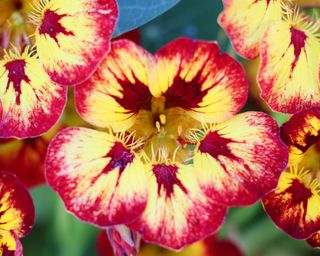
Pretty due-toned ‘Orchid Flame’ with its pink tinged yellow petals was awarded Flower Of The Year in 2019
Where to buy nasturtium seeds
If you’d like to try growing nasturtiums, here are our suggestions for the best places to buy seeds. There’s a huge range available online and at the garden center. Several varieties are suited to container growing and hanging baskets as well as conventional outdoor planting for ground cover and for training up trellises and supports. Use our quick links for an easy way to start.
Where to buy nasturtium seeds in the US:
- Shop nasturtium seeds at Amazon
- Shop nasturtium seeds at Burpee
- Shop nasturtium seeds at Home Depot
- Shop nasturtium seeds at Select Seeds
- Shop nasturtium seeds at Walmart
Where to buy nasturtium seeds in the UK:
- Shop nasturtium seeds at Amazon
- Shop nasturtium seeds at Crocus
- Shop nasturtium seeds at Dobies
- Shop nasturtium seeds at Mr Fothergill’s
- Shop nasturtium seeds at Marshalls
- Shop nasturtium seeds at Suttons
- Shop nasturtium seeds at Thompson & Morgan
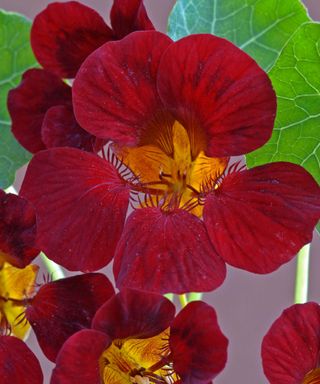
Nasturtiums such as velvety ‘black velvet’ with its profusion of deepest red blooms have a neat, compact habit

As assistant editor of Amateur Gardening magazine, Janey's gardening passion was fostered from an early age, when her amazing mum had her deadheading hydrangeas, mulching roses, and propagating strawberry plants from runners for school open days. She's also taken part in lots of conservation and rewilding projects for the RHS and TCV as a way of exploring her horticultural horizons.
